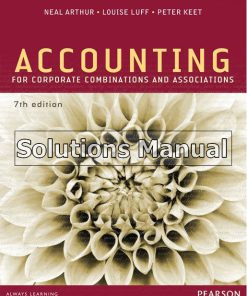Introduction to Electronic Circuit Design 1st Edition Spencer Solutions Manual
$26.50$50.00 (-47%)
Introduction to Electronic Circuit Design 1st Edition Spencer Solutions Manual.
You may also like
Introduction to Electronic Circuit Design 1st Edition Spencer Solutions Manual

Product details:
- ISBN-10 : 0201361833
- ISBN-13 : 978-0201361834
- Author: Richard R. Spencer
For two-semester/three-quarter, upper-level courses in Electronic Circuit Design.
A basic understanding of circuit design is useful for many engineers—even those who may never actually design a circuit—because it is likely that they will fabricate, test, or use these circuits in some way during their careers. This text provides a thorough and rigorous explanation of both analog and digital transistor-level circuit design with a focus on the underlying principles of how different circuits work—instead of relying completely on design procedures or “rules of thumb.” In this way, students develop the intuition that is essential to understanding and solving design problems.
Table contents:
1 Introduction 1
1.1 Circuits and Important Quantities 1
1.1.1 Electric Charge 1
1.1.2 Electric Potential (Voltage) 3
1.1.3 Electric Current 4
1.1.4 Electric Voltage and Current in Electrical Circuits 5
1.1.5 Electric Energy and Power of a Component 6
1.1.6 dc and AC Signals 7
1.1.7 Transient State and Steady State 8
1.1.8 Frequency in Circuits 9
1.2 Resistance and Resistors 9
1.2.1 Current Types, Conductance, and Ohm’s Law 10
1.2.2 Good Conductors and Insulators 10
1.2.3 Semiconductors 11
1.2.4 Superconductivity and Perfect Conductivity 11
1.2.5 Resistors as Circuit Components 12
1.3 Independent Sources 13
1.4 Dependent Sources 14
1.5 Basic Connections of Components 15
1.6 Limitations in Circuit Analysis 19
1.7 What You Need to Know before You Continue 20
2 Basic Tools: Kirchhoff’s Laws 23
2.1 Kirchhoff’s Current Law 23
2.2 Kirchhoff’s Voltage Law 24
2.3 When Things Go Wrong with KCL and KVL 36
2.4 Series and Parallel Connections of Resistors 40
2.4.1 Series Connection 40
2.4.2 Parallel Connection 41
2.5 When Things Go Wrong with Series/Parallel Resistors 45
2.6 What You Need to Know before You Continue 46
3 Analysis of Resistive Networks: Nodal Analysis 47
3.1 Application of Nodal Analysis 47
3.2 Concept of Supernode 59
3.3 Circuits with Multiple Independent Voltage Sources 72
3.4 Solving Challenging Problems Using Nodal Analysis 74
3.5 When Things Go Wrong with Nodal Analysis 86
3.6 What You Need to Know before You Continue 90
4 Analysis of Resistive Networks: Mesh Analysis 93
4.1 Application of Mesh Analysis 93
4.2 Concept of Supermesh 107
4.3 Circuits with Multiple Independent Current Sources 121
4.4 Solving Challenging Problems Using the Mesh Analysis 122
4.5 When Things Go Wrong with Mesh Analysis 135
4.6 What You Need to Know before You Continue 137
5 Black-Box Concept 139
5.1 Thévenin and Norton Equivalent Circuits 139
5.2 Maximum Power Transfer 158
5.3 Shortcuts in Equivalent Circuits 173
5.4 When Things Go Wrong with Equivalent Circuits 176
5.5 What You Need to Know before You Continue 178
6 Transient Analysis 181
6.1 Capacitance and Capacitors 181
6.2 Inductance and Inductors 191
6.3 Time-Dependent Analysis of Circuits in Transient State 195
6.3.1 Time-Dependent Analysis of RC Circuits 195
6.3.2 Time-Dependent Analysis of RL Circuits 204
6.3.3 Impossible Cases 207
6.4 Switching and Fixed-Time Analysis 208
6.5 Parallel and Series Connections of Capacitors and Inductors 218
6.5.1 Connections of Capacitors 218
6.5.2 Connections of Inductors 220
6.6 When Things Go Wrong in Transient Analysis 222
6.7 What You Need to Know before You Continue 224
7 Steady-State Analysis of Time-Harmonic Circuits 227
7.1 Steady-State Concept 227
7.2 Time-Harmonic Circuits with Sinusoidal Sources 228
7.2.1 Resistors Connected to Sinusoidal Sources 229
7.2.2 Capacitors Connected to Sinusoidal Sources 230
7.2.3 Inductors Connected to Sinusoidal Sources 231
7.2.4 Root-Mean-Square Concept 232
7.3 Concept of Phasor Domain and Component Transformation 234
7.3.1 Resistors in Phasor Domain 236
7.3.2 Capacitors in Phasor Domain 236
7.3.3 Inductors in Phasor Domain 237
7.3.4 Impedance Concept 238
7.4 Special Circuits in Phasor Domain 243
7.4.1 RC Circuits in Phasor Domain 243
7.4.2 RL Circuits in Phasor Domain 244
7.4.3 RLC Circuits in Phasor Domain 246
7.4.4 Other Combinations 247
7.5 Analysis of Complex Circuits at Fixed Frequencies 248
7.6 Power in Steady State 259
7.6.1 Instantaneous and Average Power 259
7.6.2 Complex Power 260
7.6.3 Impedance Matching 266
7.7 When Things Go Wrong in Steady-State Analysis 271
7.8 What You Need to Know before You Continue 274
8 Selected Components of Modern Circuits 275
8.1 When Connections Are via Magnetic Fields: Transformers 275
8.2 When Components Behave Differently from Two Sides: Diodes 278
8.3 When Components Involve Many Connections: OP-AMPs 284
8.4 When Circuits Become Modern: Transistors 288
8.5 When Components Generate Light: LEDs 293
8.6 Conclusion 294
9 Practical Technologies in Modern Circuits 295
9.1 Measurement Instruments 295
9.2 Three-Phase Power Delivery 297
9.3 AD and DA Converters 300
9.4 Logic Gates 303
9.5 Memory Units 307
9.6 Conclusion 309
10 Next Steps 311
10.1 Energy Is Conserved, Always! 311
10.2 Divide and Conquer Complex Circuits 313
10.3 Appreciate the Package 314
10.4 Consider Yourself as a Circuit Element 316
10.5 Safety First 317
11 Photographs of Some Circuit Elements 321
A Appendix 325
A.1 Basic Algebra Identities 325
A.2 Trigonometry 325
A.3 Complex Numbers 325
B Solutions to Exercises 327
Index 401
People also search:
introduction to electronic circuit design pdf
introduction to electronic circuit design
introduction to electronic circuits
introduction to digital circuits pdf
|
introduction to circuit design
|












